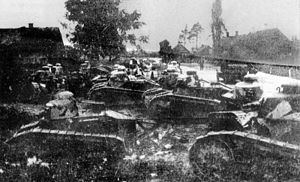22,000 Latvians20,000 Poles Unknown Dates 28 Sep 1919 – 15 Jan 1920 | Unknown Unknown | |
 | ||
Combatants Russian Soviet Federative Socialist Republic, Second Polish Republic, Soviet Russia Similar Polish–Soviet War, Battle of Lwów, Vilna offensive, Battle of Dytiatyn, Soviet westward offensive | ||
Battle of daugavpils
Battle of Daugavpils (also known as the Battle of Dyneburg) was the final battle in the Polish-Soviet campaign of 1919. A joint Polish and Latvian force, operating under Polish Staff orders known as "Operation Winter", attacked the Red Army garrison in Dunaburg, or Daugavpils, from 3-5 Jan. 1920.
From the Polish perspective it was a part of the Polish-Bolshevik War, while in Latvia it is referred to as a part of Latvian War of Independence.
The Polish commander of the 1st Legions Infantry Division and 3rd Legions Infantry Division, general (later Marshal of Poland) Edward Rydz-Śmigły had been occupying the left bank of the Dvina since Aug. The Latvian Foreign Minister had met with Pilsudski in Wilno in Oct. 1919, and asked for assistance at Dunaburg. The Poles wanted to prevent the Soviet XVth and XVIth armies from consolidating at this juncture, and readily agreed. A final agreement was reached on 30 Dec. 1919, and a military alliance was signed between the governments of Poland and Latvia.
General Rydz-Śmigły was given the command over a small Operational Group composed of his 1st Legions Infantry Division, as well as the 3rd Legions Infantry Division and several minor Latvian auxiliary forces. In addition, the force included Renault FT tanks of the 2nd company, 1st Tank Regiment, commanded by the French Capt. Jean Dufour.
The battle for the city and its surroundings took place under harsh weather conditions, the area was covered with more than 1 metre (3.3 ft) of snow and the temperature dropped below −25 °C (−13 °F), which permitted the Poles to cross the frozen Dvina. The Polish 3rd Legionary Division stormed the Daugavpils fortress, while the 1st Infantry Division attacked from the north. The Red garrison retreated to the west where they surrendered to the Latvians. On 5 Jan. 1920, Dunaburg was turned over to the Latvian Republic.
Thanks to that, the inter-war relations between Poland and Latvia were good, although Latvia refused to join Poland in its continued struggle against Soviet Russia. The problems that precluded the Polish and Latvian governments from expanding their relationship were the opposition from Lithuania (which was hostile towards Poland after the Polish-Lithuanian War) and a dispute about six Latvian rural municipalities and the city of Grīva with a big percentage of Polish inhabitants (south to the Daugava River). Several forms of alliance were proposed by Poland, such as Latvia joining the Międzymorze federation of Poland. It chose to join the Baltic Entente instead.
